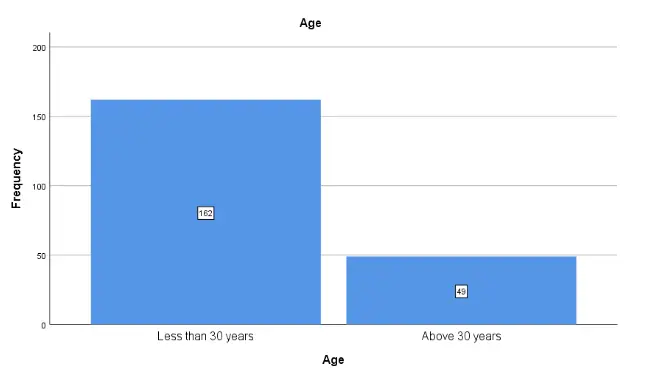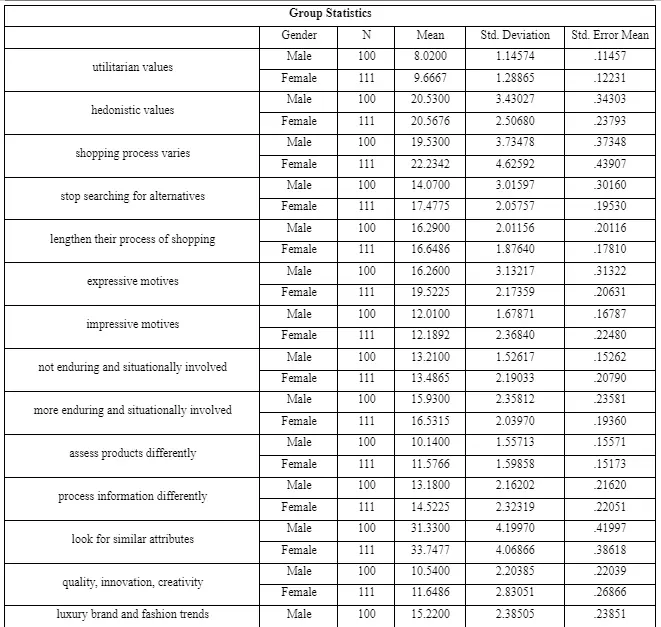Gender-Based Variations in Shopping Preferences and Values

From the above table, it can be seen that there were a total of 211 participants, out of which 100 or 47.4% were male while the remaining 111 or 53% of participants were female. This means there were more female participants in the study.


Out of the total 211 participants, age of 162 or 76.8% were less than 30 years; while 49 or 23.2% were above the age of 30 years. Thus, majority of the participants were of the younger age group.



The mean for utilitarian values in male was 8.0, and the standard deviation was 1.14; on the other hand, for female participants, it was 9.6 while the standard deviation was 1.2. Further, for hedonistic values in male, the mean was 20.53, and the standard deviation was 3.4; while the mean for female was 20.56, and standard deviation came out to be 2.50. The mean for the shopping process varies for men was 19.5, and for female participants, it was 22.23. Further, the standard deviation for male was 3.73, and for female, it was 4.623. Mean value of male participants to stop searching for alternatives was 14.0, and for female participants, it was 17.4; the standard deviation for male was 3.01 and female it was 2.05.

On an average, 16.2 male participants stated that they lengthen their process of shopping; while 16.6 female participates replied to this option. The standard deviation for male was 2.01, and for female participants, it was 1.87. Mean of male participants for expressing motives was 16.2, and the standard deviation was 3.13; while for female participants, the mean was 19.5, and the standard deviation was 2.17. Mean of impressive motives among male was 12.0, and the standard deviation was 1.67; on the other hand, mean for female participants were 12.1, and the standard deviation was 2.36.
The mean of male participants for not enduring and situationally involved was 13.2, and the standard deviation was 1.52; mean for female participants was 13.4, and the standard deviation came out to be 2.19. Mean of male for more enduring and situationally involved was 15.9 and for female, it was 16.5; on the other hand, the standard deviation for male came out to be 2.35, and for female, it was 2.03. Mean of male for assessing products differently was 10.1 and for female participants, it was 11.5; while the standard deviation for male was 1.55, and for female, it was 1.59.
Looking for further insights on Gender Diversity? Click here.
The average value of male for process information differently was 13.1, and for female, it was 14.5; and standard deviation for male was 2.16, and for female, it was 2.32. On average, 31.3 male responded that they look for similar attributes, while 33.7 female participants replied the same. Their standard deviation was 4.19 and 4.06 respectively for male and female participants. 10.5 male on average replied for quality, innovation and creativity while for female it was 11.5, and the standard deviation was 2.2 and 2.3 for male and female participants respectively. Mean of male participants for a luxury brand and fashion trends was 15.2, and for female participants, it was 15.3; the standard deviation for male was 2.3, and for female, it was 2.5. Mean for price saving dimensions for male participants was 21.4 and for female participants, it was 19.6; while the standard deviation for male was 3.37 and for female, it was 4.01.



As per the independent t-test for utilitarian values t(209) = -9.765; p = 0.000. Since the p-value is less than the critical alpha value of 0.05, it can be said that there is a statistically significant difference between the genders. Thus, H1.1 can be accepted, i.e. men have higher utilitarian values as they try to purchase luxury goods as effectively as possible.
On the other hand, for hedonistic values t(209) = -0.091; p = 0.927. As the p-value is more than the critical alpha value of 0.05, there is no statistically significant difference between the genders. This was H1.2 can be rejected. Therefore, women do not perceive shopping as more entertaining.
As per the independent t-test for shopping process varies t(209) = -4.640; p = 0.000. Since the p-value is less than the critical alpha value of 0.05, it can be said that there is a statistically significant difference between the genders. Thus, H2 can be accepted, i.e. there are differences in shopping behaviour among men and women.
As per the independent t-test for stop searching for alternatives t(209) = -9.666; p = 0.000. Since the p-value is less than the critical alpha value of 0.05, it can be said that there is a statistically significant difference between the genders. Thus, H2.1 can be accepted as men stop searching for an alternative if they feel happy and believe that the product is good enough.
On the other hand, for lengthen their process of shopping t(209) = -1.340; p = 0.182. As the p-value is more than the critical alpha value of 0.05, there is no statistically significant difference between the genders. Thus, H2.2 can be rejected, as the data suggests that women do not lengthen the process of shopping in search of better alternatives.
As per the independent t-test for expressive motives t(209) = -8.860; p = 0.000. Since the p-value is less than the critical alpha value of 0.05, it can be said that there is a statistically significant difference between the genders. Thus, H3.1 can be accepted, i.e. both men and women are attached to expressive motives.
On the other hand, for impressive motives t(209) = -0.628; p = 0.531. As the p-value is more than the critical alpha value of 0.05, there is no statistically significant difference between the genders. As per the results. H3.2 can be rejected because women are less attached to impressive motives.
As per the independent t-test, for not enduring and situationally involved t(209) = -1.053; p = 0.294. As the p-value is more than the critical alpha value of 0.05, there is no statistically significant difference between the genders. Thus, H4.1 can be rejected, i.e. men are enduring and situationally involved.
On the other hand, for more enduring and situationally involved t(209) = -1.987; p = 0.084. As the p-value is less than the critical alpha value of 0.05, there is a statistically significant difference between the genders. Thus, H4.2 can be accepted.
As per the independent t-test for assess products differently t(209) = -6.599; p = 0.000. As the p-value is less than the critical alpha value of 0.05, there is a statistically significant difference between the genders. Thus, H5 can be accepted as both men and women assess luxury products differently during the purchase process.
On the other hand, for process information differently t(209) = -4.331; p = 0.000. As the p-value is less than the critical alpha value of 0.05, there is a statistically significant difference between the genders. Thus, H6 can be accepted.

As per the independent t-test for quality, innovation and creativity t(209) = -3.150; p = 0.002. As the p-value is less than the critical alpha value of 0.05, there is a statistically significant difference between the genders. Therefore H7.1 can be accepted, which states that both men and women care for quality, innovation and creativity while buying luxury goods.
On the other hand, for luxury brands and fashion trends t(209) = -0.307; p = 0.759. As the p-value is more than the critical alpha value of 0.05, there is no statistically significant difference between the genders. Thus, H7.2 can be rejected.
Further, for price saving dimensions, t(209) = 3.431; p = 0.001. As the p-value is less than the critical alpha value of 0.05, there is a statistically significant difference between the genders. Therefore, H7.3 can be accepted, i.e. both men and women care about price saving, but each does in their own ways.
Continue your journey with our comprehensive guide to Exploring the Relationship between Innovation and Performance.
- 24/7 Customer Support
- 100% Customer Satisfaction
- No Privacy Violation
- Quick Services
- Subject Experts



